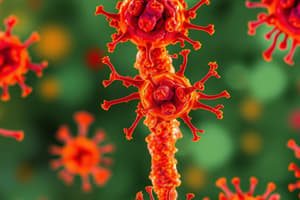Podcast
Questions and Answers
What type of microorganisms are primarily studied in food microbiology?
What type of microorganisms are primarily studied in food microbiology?
- Animals and microorganisms
- Plants and insects
- Only bacteria and yeasts
- Bacteria, fungi, and viruses (correct)
Which group of microorganisms thrives at high temperatures?
Which group of microorganisms thrives at high temperatures?
- Mesophiles
- Halophiles
- Thermophiles (correct)
- Psychrophiles
What is a common foodborne pathogen associated with serious health issues?
What is a common foodborne pathogen associated with serious health issues?
- Saccharomyces cerevisiae
- Listeria (correct)
- Bacillus cereus
- Bifidobacterium
Which food preservation method uses extreme heat to eliminate microorganisms?
Which food preservation method uses extreme heat to eliminate microorganisms?
How does pH influence microbial growth in food?
How does pH influence microbial growth in food?
What is a primary reason for practicing good hygiene during food preparation?
What is a primary reason for practicing good hygiene during food preparation?
Why is temperature control important in the food chain?
Why is temperature control important in the food chain?
Which of the following is an essential aspect of food sanitation?
Which of the following is an essential aspect of food sanitation?
How can the principles of food microbiology benefit public health?
How can the principles of food microbiology benefit public health?
What research area is currently emerging within food microbiology?
What research area is currently emerging within food microbiology?
Flashcards
Food safety in food prep
Food safety in food prep
Following hygiene practices to prevent microbial contamination during food preparation and handling.
Temperature control in food
Temperature control in food
Maintaining proper temperatures throughout the food supply chain to prevent pathogen growth.
Food sanitation procedures
Food sanitation procedures
Cleaning and disinfecting to eliminate microbial build-up.
Food microbiology importance
Food microbiology importance
Signup and view all the flashcards
Preservation methods research
Preservation methods research
Signup and view all the flashcards
Food Microbiology
Food Microbiology
Signup and view all the flashcards
Foodborne Pathogens
Foodborne Pathogens
Signup and view all the flashcards
Microbial Growth Factors
Microbial Growth Factors
Signup and view all the flashcards
Food Spoilage
Food Spoilage
Signup and view all the flashcards
Food Preservation Methods
Food Preservation Methods
Signup and view all the flashcards
Study Notes
Introduction to Food Microbiology
- Food microbiology is the study of microorganisms in food.
- It encompasses the identification, behavior, and effects of microorganisms on food safety, quality, and spoilage.
- Microorganisms of concern include bacteria, fungi (yeasts and molds), and viruses.
Microbial Growth in Food
- Microbial growth is influenced by factors like temperature, pH, water activity, and available nutrients.
- Temperature plays a crucial role:
- Psychrophiles thrive in cold environments.
- Mesophiles have optimal growth at moderate temperatures.
- Thermophiles prefer high temperatures.
- pH affects microbial growth; acidic foods generally inhibit microbial growth.
- Water activity (aw) represents the amount of unbound water available for microbial growth. Lower aw values limit growth.
- Nutrient availability influences the type and rate of microbial growth.
Foodborne Pathogens
-
Foodborne pathogens are microorganisms that can cause illness in humans if consumed in contaminated food.
-
Common foodborne pathogens include:
- Salmonella
- E. coli
- Listeria
- Campylobacter
- Staphylococcus aureus
- Clostridium botulinum
-
Pathogens can contaminate food at different stages of the food chain: production, processing, storage, and distribution.
-
Foodborne illnesses can range from mild to severe, sometimes even life-threatening.
Food Spoilage
- Food spoilage is caused by the growth and activity of microorganisms in food.
- Microorganisms produce enzymes and toxins that alter the sensory attributes of food (color, taste, and smell), making it undesirable.
- Bacteria produce lactic acid and other by-products that lead to spoilage.
- Molds and yeasts lead to discoloration and off-flavors.
- Spoilage can lead to reduced shelf life and economic losses for food producers.
Food Preservation Methods
- Food preservation methods aim to inhibit or eliminate microbial growth to extend the shelf life of food.
- Common methods include:
- Temperature control (refrigeration, freezing, pasteurization, sterilization).
- Chemical preservation (using preservatives like salt, sugar, or acids).
- Irradiation.
- Drying and dehydration.
- Fermentation.
- Each method has its own advantages and limitations regarding food safety and quality.
Microbial Control
- Maintaining food safety involves preventing contamination and controlling microbial growth.
- Good hygiene practices during food preparation and handling are crucial to minimize the risk of microbial contamination.
- Proper temperature control throughout the food chain is essential to prevent the growth of pathogens.
- Using appropriate packaging and storage methods is important to maintain food quality.
- Food sanitation includes cleaning and disinfection procedures to prevent microbial build-up.
Importance of Food Microbiology in Food Production
- Understanding food microbiology is vital for ensuring food safety and quality.
- Proper application of preservation techniques can aid in extending the shelf-life and maintaining the nutritional value of food products.
- Implementing food microbiology principles helps minimize economic losses and protect public health.
- Continuous monitoring and improvement of food safety procedures are crucial to prevent outbreaks of foodborne illness.
Emerging Areas in Food Microbiology
- Research into novel preservation methods, such as pulsed electric fields and high-pressure processing, is continually pursued.
- Studies on the role of the microbiome in food systems are emerging.
- Investigating the use of probiotics and prebiotics in food products is a growing area.
Studying That Suits You
Use AI to generate personalized quizzes and flashcards to suit your learning preferences.
Description
Test your understanding of food microbiology concepts, focusing on the behavior of microorganisms in food and their impact on safety and spoilage. This quiz covers topics such as microbial growth factors, foodborne pathogens, and the role of temperature and pH in food microbiology.




